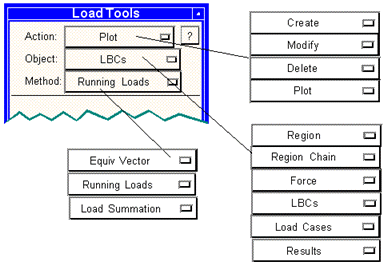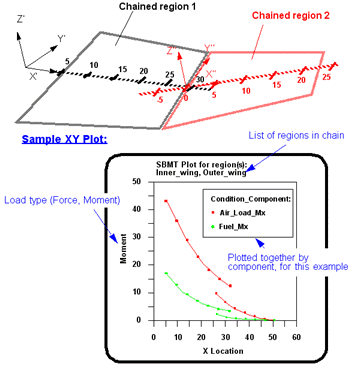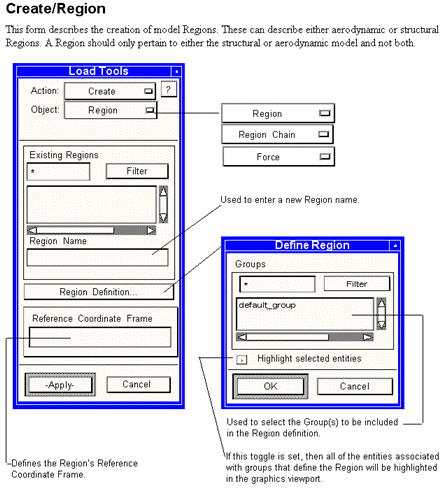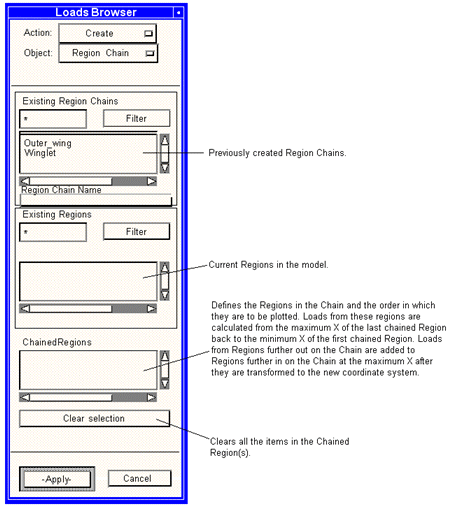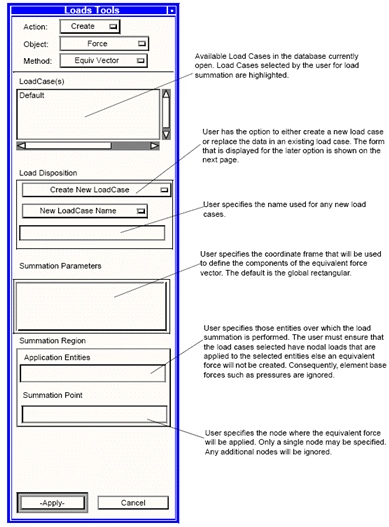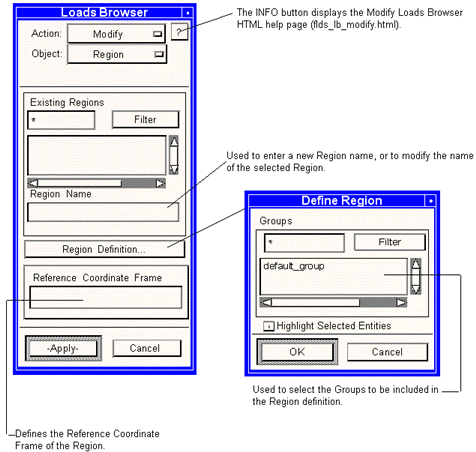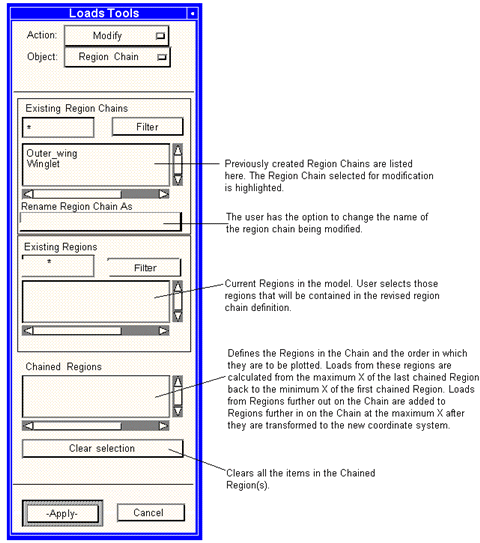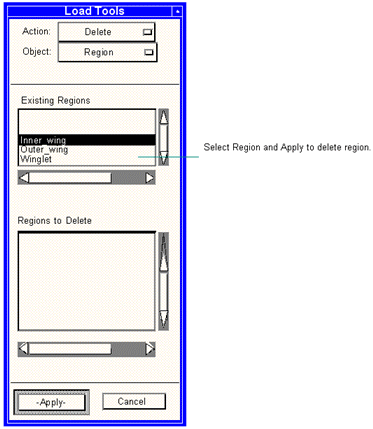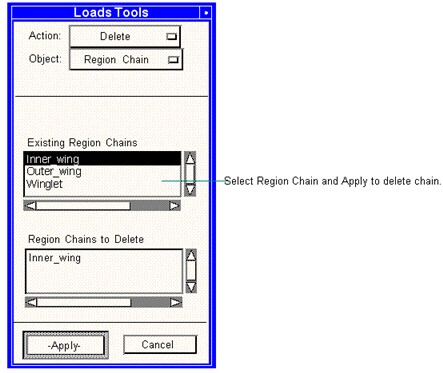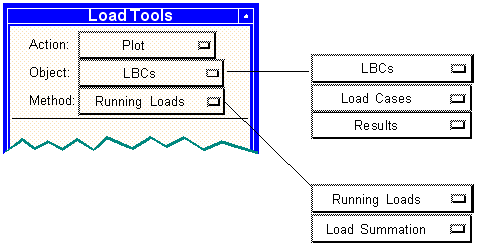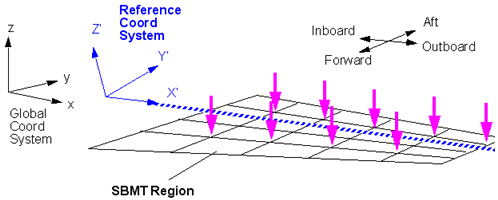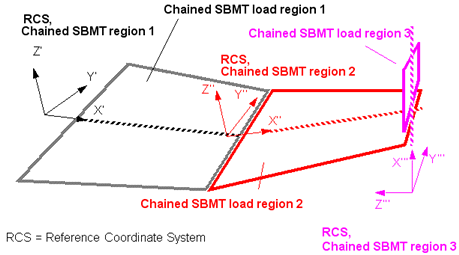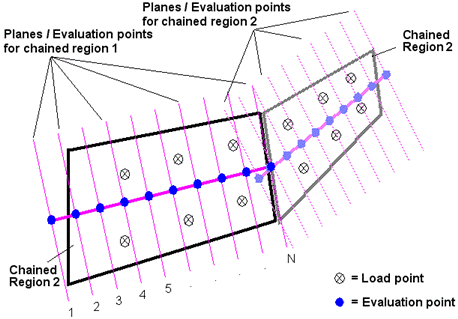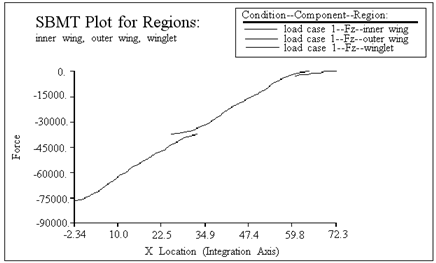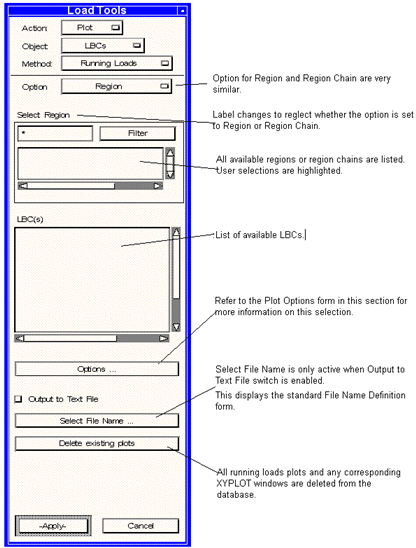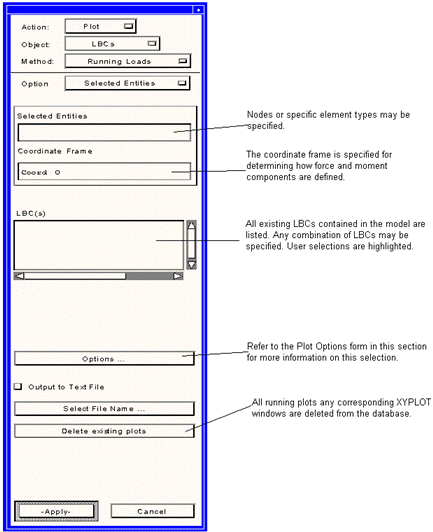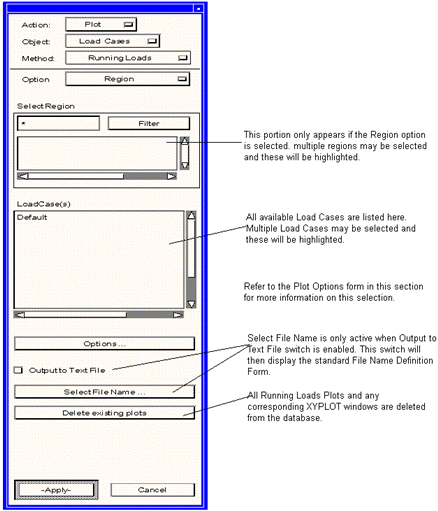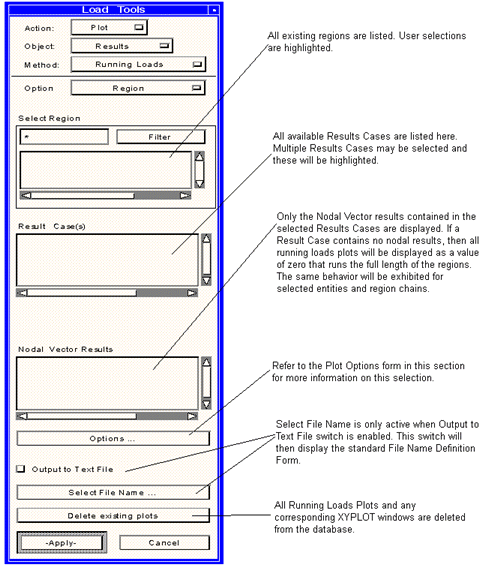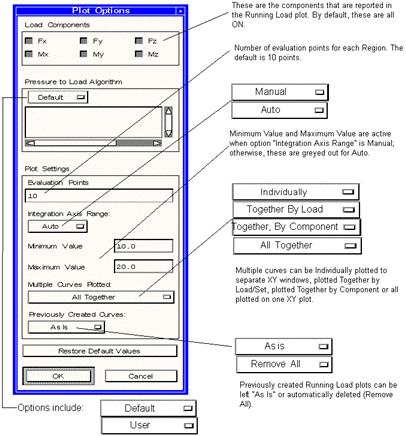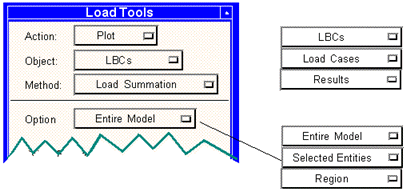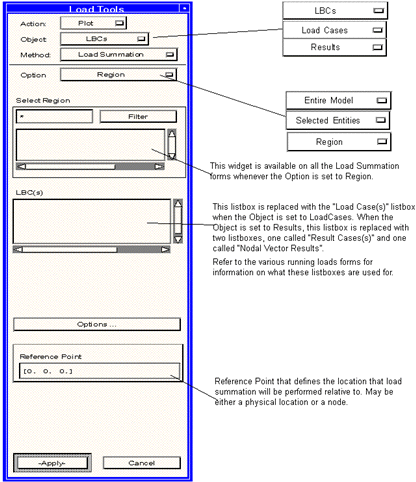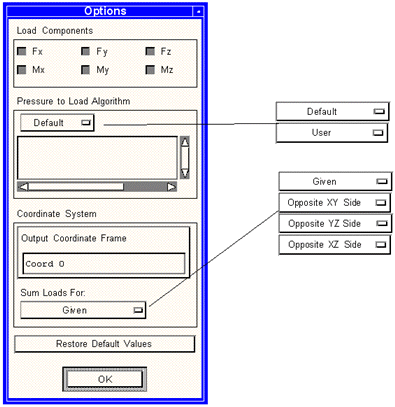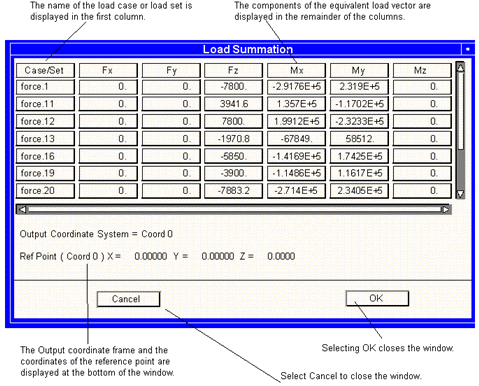XXXXXXXXXXXXXXXXXXXXXXXXXXXXXXXXXXXXXXXXXXXXXXXXXXXXXXXXXXXXXXXXXXXXXXXXXXXXXXXXXXXXXXXXXXXXXXXXXXXXXXXXXXXXXXXXXXXXXXXXXXXXXXXXXXXXXXXXXXXXXXXXXXXXXXXX''"> Loads Browsers
Visualizing resultant loads along the bending axis of a wing can be very helpful for verifying that the correct loads have been applied to a model. MSC.FlightLoads and Dynamics provides a set of XY Plotting capabilities that allow for plotting overall vehicle applied shear, bending moment, and torque (SBMT) diagrams based on the applied loading. This functionality allows for plotting overall vehicle applied SBMT diagrams along different axes for different regions of the structures.
Load Summation provides a convenient method of summing the applied vehicle loads about a spatial location.
The Loads Browser in the Results Browser module allow users the ability to create either Running Loads Plots or perform Load Summations
Overview
When Loads Browser is selected, the first form displayed is Create/Region. Shown adjacent to the form below are all the different Actions, Objects, and Method Options available.
Not all combinations of Action and Object are valid for this form. The Method option menu is only available when the Action is set to Plot or if the Action is set to Create and the Object is set to Force.
Most of the Loads Browser forms are shown and annotated in the following pages, grouped by Action as follows:
• Create (Region, Region Chain, and Force)
• Modify (Region and Region Chain)
• Delete (Region and Region Chain)
• Plot - Running Loads (LBCs, Load Cases, and Results)
• Plot - Load Summation (LBCs, Load Cases, and Results)
Loads Browser
Following is a list of the Results Browser forms and subforms related to the Loads Browser:
• Create/Region
• Create/Region Chain
• Create/Force
• Modify/Region
• Modify/Region Chain
• Delete/Region
• Delete/Region Chain
• Plot/LBCs/Running Loads
• Plot/Load Cases/Running Loads
• Plot/Results/Running Loads
• Plot -- Running Load Subforms
• Plot/LBCs/Load Summation
• Plot--Load Summation Subforms
Creation of Running Loads plots and Load Summations requires the identification of a section of the model over which the plot is to be created. This section can be described using a Region, Region Chain or on-the-fly through interactive node and element selection.
Visualizing resultant loads along the bending axis of a wing can be very helpful for verifying that the correct loads have been applied to a model. MSC.FlightLoads and Dynamics provides a set of XY Plotting capabilities that allow for plotting overall vehicle applied shear, bending moment, and torque (SBMT) diagrams based on the applied loading. This functionality allows for plotting overall vehicle applied SBMT diagrams along different axes for different regions of the structures.
Load Summation provides a convenient method of summing the applied vehicle loads about a spatial location.
The following picture illustrates the methodology behind the loads data for plots.
Load Summations can be performed using previously defined Regions or on‑the‑fly selection of nodes and elements.
Both Running Loads and Load Summation support the following kinds of external loads:
• Forces and Moments
• Pressure
• Inertia
• Distributed Edge Loads
Typically, Force and Moment loads are evaluated because they appear in the Aerodynamic/Aeroelastic database and Aeroelastic analysis results files.
Create/Region
This form describes the creation of model Regions. These can describe either aerodynamic or structural Regions. A Region should only pertain to either the structural or aerodynamic model and not both.
Create/Region Chain
Two or more Regions can be chained together and referenced as a Region Chain. A Region Chain can describe Regions with a discontinuity at their intersections (i.e., two Regions that follow a wing spar break). Region Chains can be referenced in Running Load plots. The following form is used to combine individual regions into a region chain that can be plotted in a single graph..
Create/Force
The Create Force functionality enables a user to create an equivalent force vector that is derived from all of the nodal forces within any combination of existing load cases. The user has the ability to define the load summation point where the equivalent force is applied as well as the region over which the load summation is performed. The resultant force can either be used to replace the contents of an existing load case or to create an entirely new load case.
The following form is displayed if the user selects the load disposition switch to enable the Replace Data in Load Case option. This option will cause all of the loads contained in the selected load case to be replaced with the newly created equivalent force.
Modify/Region
Previously created Regions can be modified.
Modify/Region Chain
Previously created Region Chains can be modified.
Delete/Region
Previously created Regions can be deleted from the database if they are no longer useful.
Delete/Region Chain
Previously created Region Chains can be removed from the database when they are no longer useful.
Plot
When the Action is set to Plot, the user has the ability to plot various kinds of Running Loads or Load Summation. The possible options for the form at this point are:
Plot Running Loads
To Plot Running Loads, set the Action to Plot on the Loads Browser form. The form layout is set up so that the user sets up the plot in a logical order from the top of the form to the bottom. Several sub-forms are also used to define the parameters of the plots to be generated. Users have the optional choice of writing this information to a report file.
After identifying that a Running Load plot is desired, the model’s nodes and elements must be identified either by membership to a Region, Region Chain or Selected on-the-fly.
Running Loads - Methodology
This section covers the theory and methodology behind the creation of Running Load plots and also shows the overall mathematical procedure that is used to generate the data for these plots.
Regions
The first item to be defined is the Region. The Region consists of finite elements and a reference coordinate system (see figure below).
All data reported on a Running Load plot for this Region is given in terms of the reference coordinate system. The Region covers a certain range of ordinates within the reference coordinate system. This range is from the minimum X-axis value in the reference coordinate system of the FEM nodes in the region to the maximum X-axis value in the reference coordinate system of the FEM nodes in the Region. Correspondingly, there is a Y and Z range. X is important because summation occurs along X.
Region Chains
A Region Chain may be defined. This Chain consists of an ordered list of Regions. These Regions should be adjacent and attached pieces of structure for an Running Load plot to give realistic results (see figure below). There are no checks in MSC.FlightLoads and Dynamics that prevents Region Chains from containing unattached pieces of structure.
Running Load Plots
The procedure for generating the Running Load plot data consists of accumulating the sum of the loads from the maximum X-axis location in the last Region in the Chain back to the minimum X-axis value of the first Region in the Chain. These accumulating summed loads are known as Running Loads. Each point on the resulting curve is equivalent to a load summation done at the X ordinate for all parts “outboard” (larger X value) in the region or region chain.
Running Loads are calculated at “evaluation points” for each Region. The number of points at which applied loads are summed and reported is determined by the evaluation points box on the plot form. This number is the same for all of the regions. Loads applied to the model that lie within the X-axis region of the specified coordinate system(s) are included in the Running Load plot (see figure below).
The equations used to sum the loads together for an evaluation point are as follows.
To find the beginning Running Load (load at the maximum evaluation point) for a Region, the Running Load at the minimum evaluation point of the next Region in the Chain is transformed from the reference coordinate system of the next Region in the Chain to the reference coordinate system of the current Region and then translated to the maximum evaluation point of the current Region. If the Region is the last Region in a Chain then the beginning Running Load is zero for all terms.
For the reporting Region data on Running Load plots, the first Region is plotted using its X-coordinates directly. The next Chained Regions are included by adding their X-value onto the end of this, with the origin of the second system located its value in the first coordinate system. For example, suppose a first Chained Region is defined from X’=5 to X’=32, and the second Chained Region covers X’’=-3 to X’’=23. The origin of the second Chained Region located at X’=29 in the first coordinate system. Data from the first Chained Region occupies the graph from x=5 to x=32, and the second Chained Region is plotted over x=26 to x=51.
It is very likely that two adjacent Regions will contain identical nodes. Therefore, the code checks to see if regions next to each other in a Region Chain contain identical nodes and place forces attached to only those nodes in the Region appearing first in the list. This will prevent double counting of the forces applied to these nodes. This check is only done for adjacent Regions in a Region Chain. No check is done for duplicate elements, therefore pressures applied to elements present in more than one Region in an Region Chain will be summed twice in the Running Load calculation.
A sample Running Load plot from is shown below:
Plot/LBCs/Running Loads
One or more MSC.Patran Loads/Boundary Conditions can be integrated over a model to produce a Running Load plot.
This form shows the changes that occur when the “Option” option menu is changed to “Selected Entities”. Notice that the changes are valid for all Objects (LBCs, Load Cases, Results).
Plot/Load Cases/Running Loads
One or more MSC.Patran Load Cases, which may reference multiple LBCs, can be integrated over a model to produce a Running Load plot.
Plot/Results/Running Loads
One or more Results can be integrated over a model to produce a Running Load plot. For MSC.FlightLoads and Dynamics, an XDB results file is automatically created by attachment to an Aerodynamic/Aeroelastic database. Therefore, Running Loads plots of this loads data require "Results" selection.
Plot Running Loads - Plot Options
This subform is valid for all Objects (LBCs, Load Cases, and Results) and is accessed from the Running Loads main form. It controls the appearance of the XY plot, as well as the status of previously created plots.
Plot Load Summation
Load Summations are accessed by setting the Plot Method to Load Summation. These may not be performed over Region Chains. They can only be performed on Regions or selected on-the-fly.
Load Summation - Methodology
For forces, the Load Summation calculation is simply the summation of the force vector components (transformed if necessary). The moments are calculated by determining the cross product of the force vector and the moment arm vector where the moment arm vector is a vector from the reference point to the node on which the force vector is applied.
(6‑1)

For pressure loads, the equivalent nodal loads must be calculated. The first step is to transform the element face to a local coordinate system whose normal, the vector

, is defined by the cross product of a vector from node1 to node 2, the vector

, of the face and a vector from node 1 to node 4,
(6‑2)

and
(6‑3)

.
The second local direction, the vector

, is defined by taking the cross product of

and

,
(6‑4)

.
The transformation matrix,

, is created from the direction cosines between the local system and the global system. The nodal coordinates are then multiplied by the transformation matrix.
The pressure load, like the displacements in an isoparametric finite element, is defined anywhere in the element (or on the element face for 3D elements) by
(6‑5)

| = | =the spatial distribution of the pressure load in the local element coordinate system. |
| = | =the pressures at the nodes |
| = | =the element interpolation functions. |
The equivalent nodal forces are calculated from the exact integral evaluated using Gauss-Legendre quadrature
(6‑6)

| = | =the element’s parametric coordinates. |
| = | =the pressure distribution in the element’s parametric coordinate system. |
| = | =the determinate of the Jacobian. |
| = | =the pressure at the integration points  . |
| = | =the Gauss-Legendre integration weights. |
Once calculated, the nodal loads are transformed into the global system using the transpose of the transformation matrix.
Plot/LBCs/Load Summation
This form is the same for all Objects (LBCs, Load Cases, and Results). The only change is the label on the “Select LBC(s)...” button and the subform it displays. See the previous pages where Method=Running Loads for button labels and subforms.
Plot Load Summation - Plot Options
This form is valid for all Objects (LBC, Load Cases, and Results) and is accessed from the Load Summation main form.
Select the Apply button on any of the Plot/Load Summation main forms to display the following spreadsheet.
